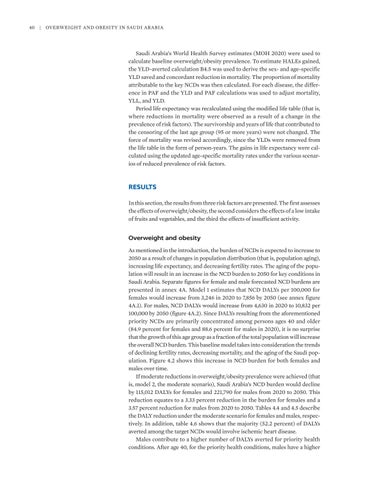40
|
Overweight and Obesity in Saudi Arabia
Saudi Arabia’s World Health Survey estimates (MOH 2020) were used to calculate baseline overweight/obesity prevalence. To estimate HALEs gained, the YLD-averted calculation B4.5 was used to derive the sex- and age-specific YLD saved and concordant reduction in mortality. The proportion of mortality attributable to the key NCDs was then calculated. For each disease, the difference in PAF and the YLD and PAF calculations was used to adjust mortality, YLL, and YLD. Period life expectancy was recalculated using the modified life table (that is, where reductions in mortality were observed as a result of a change in the prevalence of risk factors). The survivorship and years of life that contributed to the censoring of the last age group (95 or more years) were not changed. The force of mortality was revised accordingly, since the YLDs were removed from the life table in the form of person-years. The gains in life expectancy were calculated using the updated age-specific mortality rates under the various scenarios of reduced prevalence of risk factors.
RESULTS In this section, the results from three risk factors are presented. The first assesses the effects of overweight/obesity, the second considers the effects of a low intake of fruits and vegetables, and the third the effects of insufficient activity.
Overweight and obesity As mentioned in the introduction, the burden of NCDs is expected to increase to 2050 as a result of changes in population distribution (that is, population aging), increasing life expectancy, and decreasing fertility rates. The aging of the population will result in an increase in the NCD burden to 2050 for key conditions in Saudi Arabia. Separate figures for female and male forecasted NCD burdens are presented in annex 4A. Model 1 estimates that NCD DALYs per 100,000 for females would increase from 3,246 in 2020 to 7,856 by 2050 (see annex figure 4A.1). For males, NCD DALYs would increase from 4,630 in 2020 to 10,832 per 100,000 by 2050 (figure 4A.2). Since DALYs resulting from the aforementioned priority NCDs are primarily concentrated among persons ages 40 and older (84.9 percent for females and 88.6 percent for males in 2020), it is no surprise that the growth of this age group as a fraction of the total population will increase the overall NCD burden. This baseline model takes into consideration the trends of declining fertility rates, decreasing mortality, and the aging of the Saudi population. Figure 4.2 shows this increase in NCD burden for both females and males over time. If moderate reductions in overweight/obesity prevalence were achieved (that is, model 2, the moderate scenario), Saudi Arabia’s NCD burden would decline by 115,012 DALYs for females and 221,790 for males from 2020 to 2050. This reduction equates to a 3.33 percent reduction in the burden for females and a 3.57 percent reduction for males from 2020 to 2050. Tables 4.4 and 4.5 describe the DALY reduction under the moderate scenario for females and males, respectively. In addition, table 4.6 shows that the majority (52.2 percent) of DALYs averted among the target NCDs would involve ischemic heart disease. Males contribute to a higher number of DALYs averted for priority health conditions. After age 40, for the priority health conditions, males have a higher






